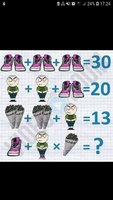Hey guys,
I came a cross this problem which is quite silly, but I'd like someone to show me where/why my math is wrong.
I know that him holding/wearing the stuff can be seen differently.
I'm posting from my phone so I'll just paste it.
See attachment for the problem.
The issue is the trickiness of the last row.
My math:
x+x+x=30
3x=30
X=10
y+y+x=20
2y+10=20
2y=10
y=5
z+z+y=13
2z+5=13
2z=8
z=4
x/2+(x*y*z) * z/2=t
5+(10*5*4) *2=t
5+200*2=t
5+400=t
t=405
Much appreciated!
I came a cross this problem which is quite silly, but I'd like someone to show me where/why my math is wrong.
I know that him holding/wearing the stuff can be seen differently.
I'm posting from my phone so I'll just paste it.
See attachment for the problem.
The issue is the trickiness of the last row.
My math:
x+x+x=30
3x=30
X=10
y+y+x=20
2y+10=20
2y=10
y=5
z+z+y=13
2z+5=13
2z=8
z=4
x/2+(x*y*z) * z/2=t
5+(10*5*4) *2=t
5+200*2=t
5+400=t
t=405
Much appreciated!
Attachments
Last edited:

